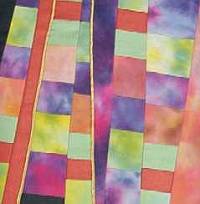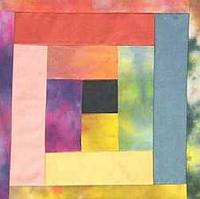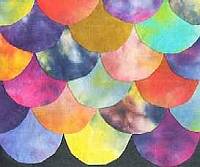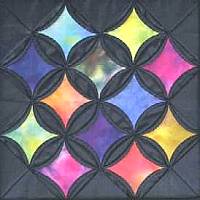Patching
Strip PatchworkThis is one of the simplest and quickest methods of producing patchwork and either hand or machine stitching can be used to join the strips. Strip patchwork is begun by sewing strips of fabric into pairs and then joining the pairs together. |

|
Seminole PatchworkThis is an extension of strip patchwork, which was developed by the Seminole Indians of Florida, who used the technique to insert strips of brilliant colour into the plain fabric of shirts, skirts and dresses. Fabric strips of varying widths are stitched together and then cut into sections and re-sewn to make a more elaborate pattern. |

|
Log Cabin PatchworkThis consists of light and dark fabrics, which are sewn to a central square working outwards. Traditionally, the central square is red and represents the chimney of the log cabin and the surrounding strips are rows of logs. Log cabin patchwork can be done either by hand or machine. This sample was done by machine |

|
Mosaic or Oversewn PatchworkThe fabric is hand sewn over paper templates and then joined together with small over sewing stitches. When complete the templates are removed. The most popular shapes are the square and hexagon. |

|
Clamshell PatchworkClamshell or Fish Scale patchwork is a variation of mosaic patchwork, however, the fabric is not sewn onto the paper templates, which are used as a guide only. One template can therefore be used to make several templates. |

|
Somerset Star PatchworkThis is a form of patchwork using small squares of fabric folded to make triangles, which are then sewn to a background fabric to make patterns of stars or crosses. Fine fabrics that crease easily are best for this technique. |

|
Cathedral Window PatchworkCathedral window is so called because the patches give a bright 'stained glass' appearance. This effect is achieved by using a plain fabric for the large patches, traditionally calico, and contrasting colours for the small fabric pieces, which are inserted. This technique has been used in one of my experimental samples using hessian for the patches with layers of fabric and wire for the insertions. |

|
« back to Manipulated Techniques page | « back to City & Guilds page | ^ top